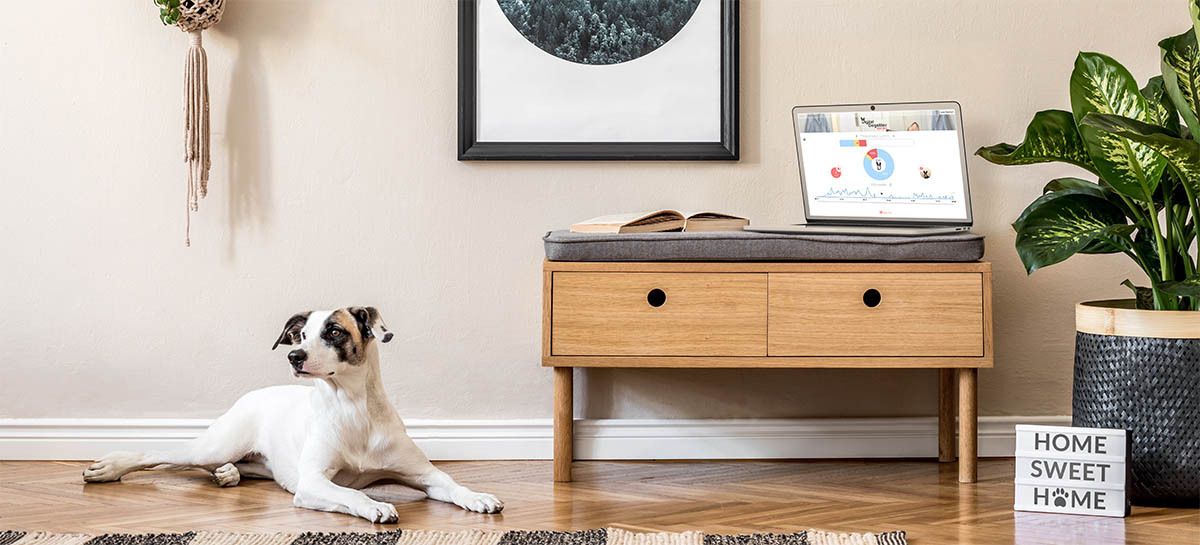If a dog is unsure of what to do when they are left alone, they may make a noise when wondering about the situation. The owner’s voice feedback can be used to interrupt and prevent this behavior before the dog gets nervous, helping them to relax.
Using audio clips of the owner's voice provides a great opportunity in the dog training process. The owner records a friendly phrase, known as voice feedback, to calm the dog, such as “Bella lies down nicely.” This can then be played to the dog whenever the owner can't be there to avoid the problematic barking when a dog is left alone. Many dogs benefit from having their barking interrupted by the owner’s reassuring instruction.
With Digital Dogsitter, it is possible to play the owner's voice clips for the dog whenever the dog’s barking exceeds a set volume level. The application makes it possible to respond to the dog automatically, even if the owner is not present and is unable to monitor the dog's actions remotely. This way, the feedback comes immediately. This works more effectively than responding a few seconds later, which would be the case if the owner was monitoring the dog on the phone and responding manually. Digital Dogsitter's remote control also allows you to monitor a real-time video of your dog, as well as turn the audio feedback off if necessary.
It is important to understand that, in addition to using the voice feedback clips, the dog’s well-being must be in order, and they must have a proper separation training process. Otherwise, there is a risk that the sound clip will work to silence the dog but will not teach them to rest while being alone. You can learn about well-being and building the training process from our comprehensive guide on dog separation anxiety and other separation-related problems.
The following sections provide information and instructions on what types of feedback audio clips to use and what other training your dog may need before using automatic feedback.
Teach a soothing phrase before using voice feedback
The soothing phrase used in the owner's feedback should already be familiar to the dog in order for the audio clip to achieve the best results. The voice of the owner alone can make the dog even more nervous if the dog does not know what the instruction means.
It is also important to keep your voice calm and confident when you record the clip. The intention is not to apologize to the dog for leaving them alone or to create uncertainty about the situation. The latter could happen if the owner’s voice on the recording sounds concerned.
How to practice the phrase:
Choose a phrase
Choose a saying that comes naturally to you. It could be, for example, “Bella waits nicely” or “That’s how Bella calms down.” The phrase may include the name of the dog, but this is not a requirement. In general, it is not recommended to repeat the dog’s name unnecessarily. But if the use is not excessive, it can help in getting them to pay attention to the sound clip. If the feedback clips work as intended and help the dog calm down quickly, the dog’s name will not be repeated too many times.
Most importantly, the soothing phrase should not be too long or too short. Three to four words is an appropriate length. The intention is that the dog has time to recognize that it is a familiar saying.
Start the training
Start using the soothing phrase in situations when your dog has just lain down to rest and is relaxed. Repeat the saying in a calm voice a couple of times. The more times a day you are able to train in a situation like this, the better your dog will learn. When you say the phrase, you can gently stroke your dog in a long, calm motion from the neck all the way to the base of the tail. But you should only do this if it relaxes your dog. If your dog gets excited by your touch, do not touch the dog while repeating the phrase.
Move to the next level in the training
After repeating the phrase for several days in rest-related situations, you can begin to invite your dog to calm down, for example, in your lap. When they are just about to rest, you can repeat the saying to them in the same way you did before when they had started to rest on their own. Only do this when your dog is in a good state to rest, such as at the end of exercise or after enrichment.
If your dog seems to be starting to calm down when they hear the soothing phrase, you can record it as your voice audio clip.
Your voice feedback must not be a "No" and should not express anger
Do not record a negative phrase or use an angry voice for your voice feedback. If a dog feels a little nervous being alone, they can begin to associate the owner’s negative feedback with being alone, and the behavior problem can be exacerbated. As a result, the training process becomes more difficult and protracted. Psychology research from around the world has repeatedly found that human anger impairs the dog’s well-being, adversely affects what is being learned, and undermines the dog’s confidence in the person.
It is difficult for a dog to feel safe when alone if this is accompanied by unpleasant feelings. Studies have also found that some dogs have an overwhelming need for attention, even if this attention is negative. If this need is strong enough, the dog will actively try to cause the reward (in this case the owner's reaction, i.e., the voice feedback) to appear, even if it results in something unpleasant for them. This can further increase the barking despite the prohibiting command and anger.
In some situations, being negative or getting angry can, in theory, silence the dog. However, this does not remove the emotional state that is behind the behavior – it only hides the symptom, i.e., barking. The dog would still bark if they dared. Thus, being alone can become more and more uncomfortable for the dog over time, and the increased anxiety can lead to, for example, illness or new behavioral problems in other areas of life.
Voice feedback helps in calming dogs down
Voice feedback can help a dog calm down, but it is not a standalone training method. The audio clip is a coping tool, which means it is one of many factors that can make it easier for your dog to be alone. This coping tool may help when used in conjunction with several other coping tools, or it may be sufficient on its own. Other coping tools may include more resting places, stimuli, or owner-scented clothing being made available to the dog when the owner can't be present. However, coping tools are only a part of separation training.
Every dog's behavior is individual. If you notice that your dog's problem behavior is intensifying after you start using your voice feedback, stop using it. Your dog may have a specific reason to respond to sound clips unusually. Since the effect of voice feedback cannot be fully assured in advance for each individual dog, we have also introduced the possibility of controlling Digital Dogsitter remotely. You can monitor your dog’s status by logging in on any device and turning off your voice feedback if needed.
Last updated Sep 18, 2025
 Train your dog to stay home alone. With love
Train your dog to stay home alone. With love  Deutsch
Deutsch English
English Español
Español Français
Français Italiano
Italiano 日本語
日本語 Português
Português Suomi
Suomi Svenska
Svenska

